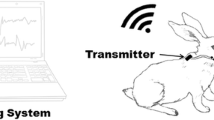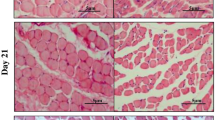Abstract
Purpose
The purpose of this study was to examine changes in the electromyographic (EMG) activity of the masseter muscle after radiofrequency therapy (RF).
Methods
Twelve rabbits were used in this study: four in each group according to the number of RF applications. Preoperative EMG in the masseter muscle was used as the control. EMG was recorded at 1, 2, 3, and 4 weeks after RF in each rabbit. The recorded data were analyzed in terms of voltage and frequency, and changes in recorded variables were compared among the groups. The relative activity in peak voltage, root mean square of the action potential, area of voltage, and area of frequency were investigated.
Results
When compared to preoperative values, the variables at 3 or 4 weeks after RF application were significantly different in the single and quadruple therapy groups (P < 0.05). There was no significant difference in the other groups (P > 0.05). When the samples were regrouped as two groups like small number of application group (one or two point) and large number of application group (three or four points), the area of voltage and the area of frequency were significantly different between the groups at 4 weeks (P < 0.05).
Conclusions
Masseter muscle activity after RF was significantly decreased compared to its preoperative state. The decreased activity was related to the number of applications and time elapsed after RF.



Similar content being viewed by others
References
Bresin A (2001) Effects of masticatory muscle function and bite-raising on mandibular morphology in the growing rat. Swed Dent J Suppl 150:1–49
Kecik D, Kocaderei I, Saatci I (2007) Evaluation of the treatment changes of functional posterior crossbite in the mixed dentition. Am J Orthod Dentofacial Orthop 131:202–215
Bresin A, Kiliaridis S (2002) Dento-skeletal adaptation after bite-raising in growing rats with different masticatory muscle capacities. Eur J Orthod 24:223–237
Glass EG, Glaros AG, McGlynn FD (1993) Myofascial pain dysfunction: treatments used by ADA members. Cranio 11:25–29
Smyth AG (1994) Botulinum toxin treatment of bilateral masseteric hypertrophy. Br J Oral Maxillofac Surg 32:29–33
Moore AP, Wood GD (1994) The medical management of masseteric hypertrophy with botulinum toxin type A. Br J Oral Maxillofac Surg 32:26–28
Göschel H, Wohlfarth K, Frevert J, Dengler R, Bigalkel H (1997) Botulinum A toxin therapy: neutralizing and nonneutralizing antibodies- therapeutic consequences. Exp Neurol 147:96–102
Powell NB, Rileyl RW, Troell RJ, Li K, Blumen MB, Guilleminault C (1997) Radiofrequency volumetric reduction of the tongue. A porcine pilot study for the treatment of obstructive sleep apnea syndrome. Chest 111:1348–1355
Powell NB, Riley RW, Troell RJ, Li K, Blumen MB, Guilleminault C (1998) Radiofrequency volumetric tissue reduction of the palate in subjects with sleep-disordered breathing. Chest 113:1163–1174
Choi SS, Rotaru H, Kim SG (2007) Treatment of post-traumatic open bite by radiofrequency. Br J Oral Maxillofac Surg 45:311–313
Song KH, Kim MH, Jung JW, Kim AS, Hong SP, Kim SG (2009) The change in dimension of the masseter muscle in rabbits after radiofrequency therapy. J Oral Maxillofac Surg 67:485–490
Gath I, Stålberg E (1975) Frequency and time domain characteristics of single muscle fibre action potentials. Electroencephalogr Clin Neurophysiol 39:371–376
Aagaard P (2004) Making muscles ‘stronger’: exercise, nutrition, drugs. J Musculoskelet Neuronal Interact 4:165–174
Park YJ, Jo YW, Bang SI, Kim HJ, Lim SY, Mun GH, Hyon WS, Oh KS (2007) Radiofrequency volumetric reduction for masseteric hypertrophy. Aesth Plast Surg 31:42–52
van Wessel T, Langenbach GEJ, Korfage JAM, Brugman P, Kawai N, Tanaka E, van Eijden TMG (2005) Fibre-type composition of rabbit jaw muscles is related to their daily activity. Eur J Neurosci 22:2783–2791
Ahn KY, Kim ST (2007) The change of maximum bite force after botulinum toxin type a injection for treating masseteric hypertrophy. Plast Reconstr Surg 120:1662–1666
Lee CJ, Kim SG, Kim YJ, Han JY, Choi SH, Lee SI (2007) Electrophysiologic change and facial contour following botulinum toxin A injection in square faces. Plast Reconstr Surg 120:769–778
Ham JW (2009) Masseter muscle reduction procedure with radiofrequency coagulation. J Oral Maxillofac Surg 67:457–464
Cosman ER, Rittman WJ, Nashold BS, Makachinas TT (1988) Radiofrequency lesion generation and its effect on tissue impedance. Appl Neurophysiol 51:230–242
Sluijter M, Racz G (2002) Technical aspects of radiofrequency. Pain Practice 2:195–200
Emilia del Pino M, Rosado RH, Azuela A, Graciela Guzmán M, Argüelles D, Rodríguez C, Rosado GM (2006) Effect of controlled volumetric tissue heating with radiofrequency on cellulite and the subcutaneous tissue of the buttocks and thighs. J Drugs Dermatol 5:714–722
Roy SH, De Luca CJ, Schneider J (1986) Effects of electrode location on myoelectric conduction velocity and median frequency estimates. J Appl Physiol 61:1510–1517
Monster AW, Chan H, O’Connor D (1978) Activity patterns of human skeletal muscles: relation to muscle fibre type composition. Science 200:314–317
Langenbach GEJ, van Wessel T, Brugman P, van Eijden TMG (2004) Variation in daily masticatory muscle activity in the rabbit. J Dent Res 83:55–59
Miyamoto K, Ishizuka Y, Ueda HM, Saifuddin M, Shikata N, Tanne K (1999) Masseter muscle activity during whole day in children and young adults. J Oral Rehabil 26:858–864
Author information
Authors and Affiliations
Corresponding author
Rights and permissions
About this article
Cite this article
Jung, JW., Song, KH., Chee, Y. et al. Electromyographic activity of the masseter muscle after radiofrequency therapy in an animal model. Oral Maxillofac Surg 14, 35–41 (2010). https://doi.org/10.1007/s10006-009-0188-y
Published:
Issue Date:
DOI: https://doi.org/10.1007/s10006-009-0188-y




